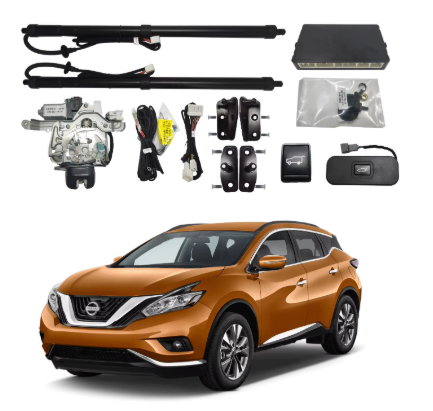Az elektromos zárós csomagtérajtó-rendszerek alapvető funkcióinak és a felhasználói elvárásoknak a megértése
Az elektromos záródású csomagtérajtó-rendszerek mára elengedhetetlen funkcióvá váltak a modern járművekben, mivel lényegesen egyszerűbbé teszik a rakomány betöltését és kirakodását a felhasználók számára. Ezek a rendszerek az elektromos alkatrészek, mechanikus elemek és szenzortechnológia kombinációját használják az ajtó automatikus kinyitásához, becsukásához és zárolásához. Ugyanakkor a felhasználók elvárásai rendkívül magasak. Azt szeretnék, ha a rendszer minden egyes alkalommal zökkenőmentesen működne, gyorsan reagálna a gomb vagy távirányító lenyomására, valamint ellenálló lenne a napi használat során felmerülő kihívásokkal szemben, például az esővel, porral vagy extrém meleggel, illetve hideggel szemben. Ha a rendszer lassan reagál, félúton megakad vagy nem záródik be megfelelően, a felhasználók azonnal ingerültté válnak. Éppen itt kezdődnek az első problémák a gépjárműipari beszállítók és gyártók oldalán. Sok olyan vezetőt hallottam már panaszkodni e témában, ami valóban komoly fejfájást okoz mindkét félnek.

Gyakori mechanikai kopási és meghibásodási problémák
Az egyik jelentős probléma a motoros zárószerkezetekkel kapcsolatban a mechanikai kopás. A rendszerhez sok mozgó alkatrész tartozik – például csuklók, zárak és kapcsolókarok –, amelyek minden egyes hátsó ajtó használatkor egymás ellen súrlódnak. Idővel ez az állandó súrlódás az alkatrészek kopásához vezethet. Például, ha a zár mechanizmus lekopik, az nem záródik megfelelően a fogadóelemmel, így a hátsó ajtó nem záródik biztonságosan. A port és apró szennyeződések is felhalmozódhatnak ezekben a mechanikus alkatrészekben, különösen, ha a járművet gyakran poros úton vagy esős időben használják. Ez a lerakódás nehezíti az alkatrészek mozgását, és időnként akár teljesen meg is akadályozhatja a rendszer működését. Emellett, ha az alkatrészek alacsony minőségű anyagokból készültek, a probléma még súlyosabbá válik. Ezek az alkatrészek nem bírják ki a gyakori használatot vagy a nehéz körülményeket, így gyorsabban elhasználódnak – ez pedig gyakoribb javításokat vagy cseréket eredményez. Olyan, mintha egy olcsó cipőt vásárolnánk – néhány hét után szétesik, és végül több pénzt költünk rá a hosszú távon.
Elektromos alkatrészek meghibásodása és azok hatása
Az elektromos alkatrészek azok, amelyek működéséhez a motoros záródású csomagtérajtó rendszerek szükségesek, ugyanakkor ezek jelentik a hibák gyakori forrását is. A vezetékek, érzékelők és motorok különféle okokból meghibásodhatnak. Például, ha a vezetékek megsérülnek – például a jármű rázkódásától vezetés közben, vagy attól, hogy víz jut be a rendszerbe – rövidzárlat keletkezhet. Ez a rövidzárlat miatt az ajtó nem reagál, sőt akár az autó akkumulátora is lemerülhet. Az érzékelők, amelyeknek az a feladata, hogy észleljék, ha valami útban van, amikor az ajtó záródik, szintén problémásak lehetnek. Ha egy érzékelő piszkos, vagy helytelenül működik, akkor nem észleli az akadályt, ami miatt az ajtó véletlenül valamire – vagy valakire – záródhat. Vagy épp ellenkezőleg, akkor is akadályt érzékelhet, amikor nincs is ott semmi, így az ajtó egyáltalán nem záródik be. A motorok, amelyek az ajtó nyitását és zárását végzik, szintén elhasználódhatnak, különösen, ha túl gyakran használják őket. Egy gyenge motor miatt az ajtó lassan mozog, és végül teljesen meghibásodhat. Korábban már eltűnődtem azon, hogy vajon ezek a motorok elég tartósak-e a napi használathoz – néha úgy érzi az ember, hogy nem készültek olyan hosszú élettartamra, mint maga az autó.
Integrációs kihívások a járműrendszerekkel
A motoros zár mechanizmú csomagtérajtó rendszerek nem működnek önállóan – jól kell illeszkedniük a jármű más részeihez, például a központi zárrendszerhez, a kulcs nélküli belépéshez, sőt akár az infotainment rendszerhez is. Azonban ennek zökkenőmentes működése nem mindig egyszerű feladat. A különböző autómodelleket eltérő villamos kialakítás és szoftverek vezérlik, így egy motoros zár mechanizmus, ami az egyik modellnél működik, nem biztos, hogy működni fog egy másiknál. Például, ha a rendszer nem tud megfelelően kommunikálni a központi zárrendszerrel, akkor a csomagtérajtó nem záródik be, amikor a vezető lezárja a többi ajtót. Vagy ha nem szinkronizálódik a kulcs nélküli belépéssel, akkor a vezető esetleg nem tudja a távirányítójával kinyitni a csomagtérajtót. A szoftverhibák szintén gondot okozhatnak. Egy apró hiba az autó szoftverében azt is okozhatja, hogy a motoros zár mechanizmus helytelen jeleket kap, ami furcsa problémákhoz vezethet – például a csomagtérajtó önmagától kinyílik, vagy nem nyílik ki, amikor kellene. Olyan ez, mint néha egy négyzetes cöveket kör alakú lyukba próbálni illeszteni – sok mindent ki kell finomítani, hogy működjön.
A tartósság és a súlykövetelmények közötti egyensúlyozás
Egy másik probléma az, hogy egyensúlyt kell találni a rendszer élettartama és súlya között. A modern autók mind arról szólnak, hogy minél könnyebbek legyenek, így kevesebb üzemanyagot használnak és kevesebb károsanyag-kibocsátást produkálnak. Ennek megfelelően azok, akik ezeket a rendszereket tervezik, azt szeretnék, ha azok lehetőleg minél könnyebbek lennének. Ugyanakkor a rendszer könnyítése gyakran vékonyabb anyagok vagy kisebb alkatrészek használatát jelenti, ami csökkentheti a rendszer tartósságát. Például egy könnyű műanyag zár nem biztos, hogy olyan erős, mint egy fémből készült, és könnyen eltörhet, ha valaki véletlenül nagyot csap a csomagtérajtóval. Másrészről, ha tartósabb anyagokat használunk a rendszer hosszabb élettartamának biztosításához, akkor a többletsúly növeli az autó össztömegét – ez pedig növeli az üzemanyag-fogyasztást. Igazi dilemma áll előttünk – a rendszernek elég erősnek kell lennie ahhoz, hogy az autó teljes élettartama alatt működjön, ugyanakkor elég könnyűnek is kell lennie, hogy illeszkedjen az autó általános súlycéljaihoz. Szerintem ez az egyik legnehezebb terület a tervezők számára; itt valóban nagyon finoman kell egyensúlyozniuk.
Időjárási és környezeti ellenállás problémák
Az elektromos záródású csomagtérajtó-rendszerek minden időjárásnak és környezeti körülményeknek kitéve vannak, ami komoly probléma. Az eső, hó, jég és só (amilyet a téli utakon szórnak) mind károsíthatja a rendszert. A víz behatolhat az elektromos alkatrészekbe, rozsda keletkezhet, illetve rövidzárlat is előfordulhat. A só feloldhatja a fémalkatrészeket, amelyek ettől gyengébbé és törékenyebbé válnak. A szélsőséges hőmérsékletek szintén problémát jelentenek. Amikor nagyon meleg van, a műanyag alkatrészek megolvadhatnak vagy rideggé válhatnak. Amikor nagyon hideg van, a mechanikus alkatrészekben lévő olaj megfagyhat, így az ajtó nehezen mozgathatóvá válik. A por és homok is behatolhat a rendszerbe, elkop tatva az alkatrészeket, és elakadásokat okozva. Ennek megoldásához a gyártóknak olyan anyagokat kell használniuk, amelyek ellenállnak a rossz időjárásnak, valamint tömítésekkel és védőburkolatokkal kell védeni a rendszert. Ezek azonban többletköltséget és többletsúlyt jelentenek – így újabb problémával szembesülünk. Személyautókat is láttam már, amelyek csomagtérajtói egy hózú tél után működésképtelenné váltak, tehát ez a kérdés mindenképpen komolyabb figyelmet igényel.
Megfelelés a felhasználói biztonsági szabványoknak és előírásoknak
A biztonság minden autófunkció esetén elsődleges szempont, és ez érvényes az elektromos zárós csomagtérajtó-rendszerekre is. Ezeknek a rendszereknek szigorú biztonsági előírásokat kell követniük annak érdekében, hogy ne okozzanak sérüléseket a felhasználóknak. Például a rendszernek le kell állítania a csomagtérajtó zárását, ha akadályt érzékel – ez annak megelőzésére szolgál, hogy személyi sérülés történjen, például egy gyermek keze belegabalyodjon az ajtóba. A rendszerhez hozzá kell tartozzon egy tartalék mechanikus módja is az ajtó kinyitásának, ha áramkimaradás történik, így biztosítva, hogy a felhasználók ne rekedjenek rajta, ha az elektromos rendszer meghibásodik. Ezeknek az előírásoknak a teljesülése nem egyszerű feladat. Ez azt jelenti, hogy további alkatrészeket, például akadályérzékelő szenzorokat és kézi kioldó eszközöket kell beépíteni, ami bonyolultabbá és drágábbá teszi a rendszert. Emellett a biztonsági előírások országonként eltérhetnek. Ezért egy olyan rendszer, amely megfelel az előírásoknak egy adott helyen, esetleg módosításokra szorul, hogy megfeleljen egy másik országban érvényes előírásoknak. Ez további munkát jelent az autógyártók számára, akik világszerte értékesítenek járműveket. Örülök, hogy ezek a biztonsági előírások léteznek, de látom, hogy mennyivel nehezebbé teszik a gyártók dolgát – rengeteg akadályt kell átugraniuk.
Az innováció szerepe ezekben a kihívásokban való túljutásban
Az új ötletek kitalálása kulcsfontosságú a problémák megoldásához az elektromos zárrendszerrel ellátott csomagtérajtó-konstrukciókban, és itt tudnak segíteni a megfelelő technikai háttérrel rendelkező vállalatok, mint például a Desay. Például új, könnyű, mégis strapás anyagok – mint például a nagy szilárdságú alumínium vagy a tartós műanyag – használatával elérhető a súly és a tartósság közötti optimális egyensúly. A fejlettebb érzékelőtechnológia, mint például ultrahangos vagy infravörös érzékelők, javíthatja az akadályfelismerést és a különböző időjárási viszonyok közötti megbízható működést. Az intelligens szoftverek szintén megoldhatják az integrációs problémákat – ezek programozhatók különböző autórendszerekhez való alkalmazásra, és frissíthetők a hibák kijavítására idővel. A kutatás és fejlesztés területére fordított nagyobb beruházással a vállalatok olyan elektromos zárrendszerrel ellátott csomagtérajtó-konstrukciókat hozhatnak létre, amelyek megbízhatóbbak, hosszabb élettartamúak és biztonságosabbak. Így kielégíthetők az autógyártók és a sofőrök igényei egyaránt. Szerintem ha több vállalat fókuszálna ezekre az újításokra, jövőre sokkal kevesebb problémával találkoznánk ezeknél a csomagtérajtó-rendszereknél – remélhetőleg mind két kézzel.



 Forró hírek
Forró hírek